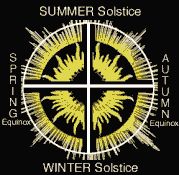| PREV | NEXT |
 Since the year is circular, in that the four seasons of the year just cycle endlessly,
it's somewhat arbitrary where we declare the start of the year to be. There are, however,
a few natural places to start the year.
Since the year is circular, in that the four seasons of the year just cycle endlessly,
it's somewhat arbitrary where we declare the start of the year to be. There are, however,
a few natural places to start the year.
One natural place to start the year is at the Winter Solstice (December 22). This is the day the Sun is lowest in the sky, making this the shortest day of the year. From this point on the Sun gets higher and higher in the sky each day, making each day longer and longer.
Another often used place to start the year is at the Vernal Equinox (also called the Spring Equinox; March 21). On this day the Sun rises directly in the East, and day and night are of equal length. It's around here the harvest cycle begins. Time to plant some crops. The Astrology section of the newspaper always begins with Aries, Mar. 21, which is the Spring Equinox.
The Jewish calendar begins with the month of Nisan, around mid-March to early April, a date hovering around the Vernal Equinox. The twelve months of the Jewish calendar are: 1)Nisan; 2)Iyyar; 3)Sivan; 4)Tammuz; 5)Ab; 6)Elul; 7)Tishri; 8)Cheshvan; 9)Kislev; 10)Tebeth; 11)Shebat; 12)Adar. This is a lunar calendar synced to the phases of the moon. A new moon begins a new month. The twelve lunar months total 354 days. To keep this calendar somewhat in sync with the solar year, a 13th "leap month" is occasionally added, called Adar II.
To further confuse things, the Jewish New Year, "Rosh Hashana," is celebrated on the first of Tishri, the seventh month, sometime in September or early October, a date hovering around the Autumnal Equinox.
The Gregorian Calendar we use today sets the start of the new year on January 1, ten
days after the Winter Solstice. Here is the explanation how that came to be:
| "The 25th of December is the winter solstice by the Julian calendar. Julius Caesar adopted what is now known as the Julian solar year of three hundred and sixty five and one-quarter days. The three hundred and sixty five days were assigned to a year of twelve months, and the remaining quarter of a day was intercalated into every fourth year, known to us as 'the leap year'. Leap years are so called, because written in the 1604 edition of the Anglican prayer book was, 'On every fourth year, the Sunday Letter Leapeth'. Julius Caesar began his new solar calendar of Rome with January 1st in the year AUC 707 (45 BCE).1 Caesar did not commence the New Year on the winter solstice (22nd December), which he knew was the true beginning of the year. He wished to prevent disruption to the traditional, moon-regulated, commercial calendar as well as for the purpose of general convenience. Caesar adopted the rule of the moon and started the New Year by making it commence on the first new moon following the winter solstice. This happened to be ten days after the solstice and, hence, our 'New Year' is not the beginning of a new year at all. Consequently, we have at present three celebrations of the winter solstice or New Year. We have the astronomical or true New Year on the 22nd of December10; Christmas, the universal celebration of the rebirth of the sun—the resurrection of the Sun God; and, Julius Caesar's moon-fixed New Year, the 1st of January."2 |
1. The Sun is born, or re-born, on December 25th.
[Jesus is born on Christ-mas day, December 25th. Actually, knowledgable Christians
will admit the tradition of celebrating Jesus' birth on December 25 was an attempt to
place a Christian significance on a pagan holiday. Pope Julius (350 CE) assigned the
birth of Jesus to December 25.3
Pagans of numerous solar religions celebrated the birth of their Sun God on December
25th. What Christians don't realize is how much more of their religion has been borrowed
from pagan religions. Christians admit they don't know what day Jesus was born. They
don't even know what year he was born. This just raises a lot more questions about how
much they don't know.]
| PREV | NEXT |